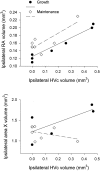Afferent input is necessary for seasonal growth and maintenance of adult avian song control circuits
- PMID: 11264307
- PMCID: PMC6762386
- DOI: 10.1523/JNEUROSCI.21-07-02320.2001
Afferent input is necessary for seasonal growth and maintenance of adult avian song control circuits
Abstract
The neural circuits that regulate song behavior in adult songbirds undergo pronounced seasonal changes in morphology, primarily in response to changes in plasma testosterone (T). Most song nuclei have T receptors. We asked whether seasonal growth and maintenance of nuclei within these circuits are direct responses to the effects of T or its metabolites or are mediated indirectly via the effects of T on afferent nuclei. Photosensitive white-crowned sparrows were exposed to one of three treatments. (1) The neostriatal nucleus HVc (also known as the "high vocal center") was lesioned unilaterally, and the birds were exposed to long-day (LD) photoperiods and breeding levels of T for 30 d. (2) Birds were exposed to LD plus T (LD+T) for 30 d; then HVc was lesioned, and the birds were killed after an additional 30 d exposure to LD+T. (3) HVc was lesioned, and the sparrows were housed on short-day (SD) photoperiods in the absence of T treatment for 30 d. In both LD+T groups, the direct efferent targets of HVc, the robust nucleus of the archistriatum (RA) and area X, were smaller ipsilateral to the lesion. The lesion did not prevent growth of the hypoglossal motor nucleus, which does not receive direct afferent input from HVc. RA and area X were also smaller ipsilateral to the lesion in the SD birds. These results indicate that afferent input is required both for the growth of adult song circuits in response to typical breeding photoperiod and hormone conditions and for the maintenance of efferent nuclei in either their regressed or enlarged states.
Figures





Similar articles
-
Breeding conditions induce rapid and sequential growth in adult avian song control circuits: a model of seasonal plasticity in the brain.J Neurosci. 2000 Jan 15;20(2):854-61. doi: 10.1523/JNEUROSCI.20-02-00854.2000. J Neurosci. 2000. PMID: 10632615 Free PMC article.
-
Act locally and think globally: intracerebral testosterone implants induce seasonal-like growth of adult avian song control circuits.Proc Natl Acad Sci U S A. 2002 Sep 17;99(19):12421-6. doi: 10.1073/pnas.192308799. Epub 2002 Sep 6. Proc Natl Acad Sci U S A. 2002. PMID: 12218180 Free PMC article.
-
Brain-Derived Neurotrophic Factor Has a Transsynaptic Trophic Effect on Neural Activity in an Adult Forebrain Circuit.J Neurosci. 2020 Feb 5;40(6):1226-1231. doi: 10.1523/JNEUROSCI.2375-19.2019. Epub 2019 Dec 19. J Neurosci. 2020. PMID: 31857358 Free PMC article.
-
Plasticity of the adult avian song control system.Ann N Y Acad Sci. 2004 Jun;1016:560-85. doi: 10.1196/annals.1298.006. Ann N Y Acad Sci. 2004. PMID: 15313795 Review.
-
Seasonal plasticity in the song control system: multiple brain sites of steroid hormone action and the importance of variation in song behavior.Ann N Y Acad Sci. 2004 Jun;1016:586-610. doi: 10.1196/annals.1298.043. Ann N Y Acad Sci. 2004. PMID: 15313796 Review.
Cited by
-
The estrous cycle and 17β-estradiol modulate the electrophysiological properties of rat nucleus accumbens core medium spiny neurons.J Neuroendocrinol. 2022 Jun;34(6):e13122. doi: 10.1111/jne.13122. Epub 2022 Apr 2. J Neuroendocrinol. 2022. PMID: 35365910 Free PMC article. Review.
-
Seasonal changes in androgen receptor mRNA in the brain of the white-crowned sparrow.Gen Comp Endocrinol. 2010 Mar 1;166(1):66-71. doi: 10.1016/j.ygcen.2009.08.001. Epub 2009 Aug 15. Gen Comp Endocrinol. 2010. PMID: 19686750 Free PMC article.
-
Breeding conditions induce rapid and sequential growth in adult avian song control circuits: a model of seasonal plasticity in the brain.J Neurosci. 2000 Jan 15;20(2):854-61. doi: 10.1523/JNEUROSCI.20-02-00854.2000. J Neurosci. 2000. PMID: 10632615 Free PMC article.
-
Rapamycin blocks the neuroprotective effects of sex steroids in the adult birdsong system.Dev Neurobiol. 2019 Aug;79(8):794-804. doi: 10.1002/dneu.22719. Epub 2019 Sep 23. Dev Neurobiol. 2019. PMID: 31509642 Free PMC article.
-
Vernal growth of vocal control nucleus Area X, but not HVC, precedes gonadal recrudescence in wild black-capped chickadees (Poecile atricapillus).J Neuroendocrinol. 2025 Jun;37(6):e13375. doi: 10.1111/jne.13375. Epub 2024 Feb 20. J Neuroendocrinol. 2025. PMID: 38379225 Free PMC article.
References
-
- Arnold AP, Nottebohm F, Pfaff DW. Hormone concentrating cells in vocal control and other areas of the brain of the zebra finch (Poephila guttata). J Comp Neurol. 1976;165:487–511. - PubMed
-
- Balazs R, Hack N, Jorgensen OS, Cotman CW. N-methyl-d-aspartate promotes the survival of cerebellar granule cells: pharmacological characterization. Neurosci Lett. 1989;101:241–246. - PubMed
-
- Ball GF. Neuroendocrine basis of seasonal changes in vocal behavior among songbirds. In: Hauser M, Konishi M, editors. Neural mechanisms of communication. MIT; Cambridge, MA: 2000. pp. 213–253.
Publication types
MeSH terms
Substances
Grants and funding
LinkOut - more resources
Full Text Sources
Research Materials
